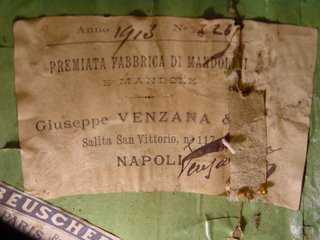Tedesco / Venzana
Giovanni Tedeseco Mandolin
A typical label used before 1900: More ornate and with the
mentioning of various expositions and prizes won by
this Naples based builder
The back had to be refinsihed as a result of necessary reparations.
I aged the maple again so the beautiful yellowing is still there.
You can click on this picture to enlarge it.
A nice close grained soundboard that is crackfree as well!
It received a new rosewood fingerboard and frets.
Giuseppe Venzana Mandolins
This is a more deluxe model from Giuseppe Venzana,
a pupil of the Vinaccia brothers. The sound of his
mandolins are in fact close to those of the Vinaccia
dynasty but luckily a lot cheaper!
The restored back of this beautiful example of Vernzana's
work. Closed tuners as was common on more deluxe models.
The label states it to be built in 1913. Paul Beuscher, a music dealer
in Paris imported a lot of products labeling them with his well
known blue label (lower left corner.)
Beuscher sometimes even branded the instruments with
Paul Beuscher - Boulevard Beaumarchais - Paris.
Nicely done woodwork and inlays and the newly added
fingerboard. Strangely enough the octace pitch wasn't
right so this move had to be made in order to make
it playable in the first place.
Giuseppe Venzana
but no less in sound! Full sound and even response of the
different string pairs.
In a 1900 catalogue Beuscher talks about the import of
Venzana and Adamo (see the beginning of this site)
mandolines. The Adamo is, as stated before very surprising!
I like the woods!
Giuseppe Venzana 1922
A 1922 Venzana in restauration process. In fact quite a plain
instrument but with a good bowlshape and even the plain
ones have the qualities as Venzana is thought to have
learned the building of mandolins at the Vinaccia workshops.
An extended rosewood fingerboard will be added.
mostly thicker made in order to resist stringpressure.
The restored 1922 Venzana mandolin. The center seam
has been filled with a small piece of wood and the bridge
has been replaced with an original old one. The double
octave rosewood fingerboard was another addition.
A beautiful rounded back that in my opinion is responsible
for the very good sound qualities of this mandolin.
The simpler label of later times but still handsigned.
Above barely visible but still there: The year of
manufacturing this instrument 1922. These
mandolins have been sold by Paul Beuscher Paris
and the extra sticker can be partly seen below.


















0 Comments:
Post a Comment
<< Home